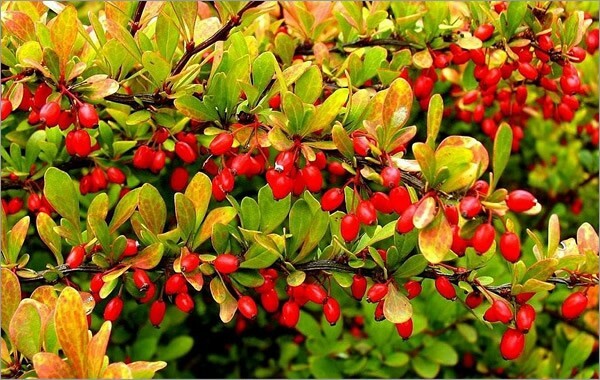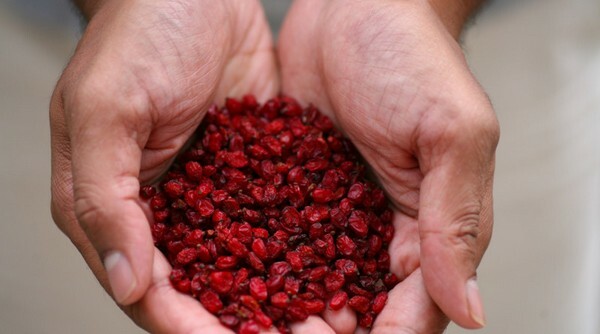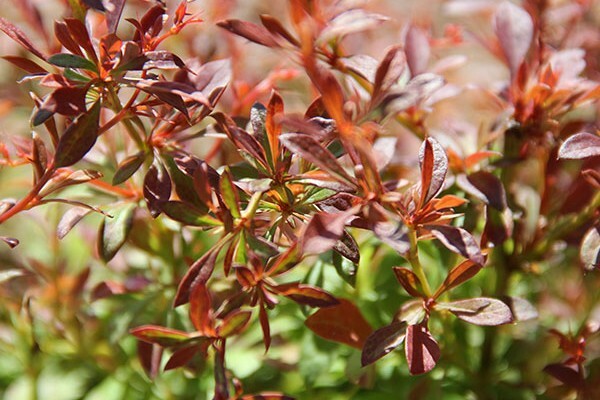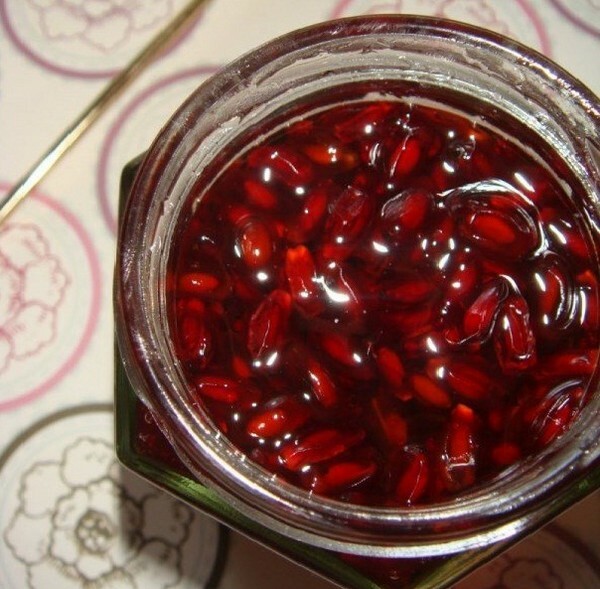- A bit of biology
- Useful properties
- Application
- Contraindications
- Recipes
We will review the useful properties and contraindications of barberry from the biology of the plant and the minerals it contains. This will help us when studying the application of barberry in various areas of human activity: in medicine and cooking.

A bit of biology
Barberry is a low shrub of the same family, it is found almost everywhere in Europe: from the Spanish coast to St. Petersburg, some of its species are found in Kazakhstan and in Central Asia, China and India. Unlike most plants, all the parts of barberry have useful properties: from leaflets to roots.
Barberry flowers in May and June, and fruiting, depending on the species and variety, can begin in July and September and continue until late autumn.
Useful properties of
The benefits of barberry were known even in the ancient world. In the written sources of Babylon and ancient India, which have survived to this day, there are references to the use of berries from plants in the struggle against jaundice and scurvy. The property of plant juice, which improves blood coagulability, was used to stop bleeding in wounds of various types.
The main substance, which is valuable barberry, alkaloid berberine. This substance helps with diseases of the gastrointestinal tract, with diabetes. It is prescribed to lower blood cholesterol and glucose in the liver.
Attention! Before using berberine and other medicines, consult your doctor!
In addition to berberine, the plant is rich in other useful substances, and their content is different in different parts of the shrub. Further, the story of what barberry is useful for, we will consider in relation to its individual components.
Berries
Barberry berries contain a very rich palette of various valuable substances. Judge for yourself, they present:
- sugars - up to 7%;
- tanning and dyeing substances - up to 0.8%;
- pectin - up to 0,6%;
- of malic acid - up to 7%.
In addition, the fruit contains such a useful vitamin "C", the amount of which can reach 100 mg%, which really makes barberry an excellent antiscorbutic.

Bioflavonoids - plant substances of the vitamin "R" group are called to strengthen vascular capillaries. Their content in berries of barberry is up to 500 mg%.
In addition, fruits contain up to 75 mg% of various alkaloids.
Our reference! Mg% is an off-system unit of substance concentration. In fact, 1 mg% is equal to 10 milligrams of the substance dissolved in a liter of water.
Separately, we will isolate barberry grains, which are 15 percent oil.
Leaves
The leaves of barberry also contain various valuable substances. First of all, this is already mentioned by us Berberine, except for it there are:
- ascorbic acid;
- tocopherols;
- carotene;
- organic acids.

Root
The roots of barberry are rich in various alkaloids. Their concentration can reach up to ten percent. Since alkaloids are easily washed out of the plant, it is strictly forbidden to wash them when harvesting the roots.
Application of
Barberry is widely used both in cooking and in medicine. And, if the culinary component uses, in the main, only ripe berries of the plant, then for the medicinal purposes all parts of the plant are good.
Cooking
Every person will find something in his barberry. Someone uses it as a spice, someone - as a sweet. Therefore, it is used in different recipes.
As spice barberry is perfectly combined with meat, giving it a subtle note with a barely noticeable sourness. Surely many have heard or applied dry berries when cooking pilaf. Real connoisseurs say that pilaf without barberry is not pilaf, but fried rice porridge.
Continuing the conversation about the use of barberry as a seasoning, we note that on the basis of its berries are obtained excellent spicy sweet and sour sauces.
Now about sweet stuff. Here everything is at the discretion of any mistress. Fresh berries of barberry are made exactly the same blanks as from berries of other trees or shrubs. To your table you can prepare the following sweet dessert dishes from barberry:
- refreshing compote;
- sweet syrup;
- vitamin juice;
- charming jam;
- is a charming jelly;
- delicious marmalade.
Attention! It is strictly forbidden to eat unripe berries of barberry. This is fraught with severe poisoning.

Medicine
From the medical point of view, it is more convenient for us to list the diseases and ailments, from which the sufferer can be cured with the help of drugs based on barberry. It is worth noting that dried barberry retains the useful properties of a fresh plant, but since it is more convenient to store and use at any time of the year, it is mainly for the preparation of medicinal potions that it is used.
On the shelves in modern pharmacies you can find dried parts of barberry, separately sold and bark, and the leaves and roots of the plant. Here, there are also various medications made on its basis. Dry berries are easier to meet in the food markets among other spices.
So, barberry is used in the following cases:
- as a cholagogue;
- with hypotension of the uterus after childbirth;
- as hemostatic;
- for cholecystitis;
- for problems with the liver and gallbladder;
- for diabetes mellitus;
- in the treatment of certain oncologies;
- for the stimulation of appetite;
- as a diuretic;
- as a mild laxative;
- as antipyretic;
- as soothing;
- as an astringent and anti-inflammatory agent.
Thanks to pectin content, barberry-based preparations are used to remove toxins, slags and heavy metal salts from the body.
In addition, barberry is due to its curative laxative and diuretic properties are included in the composition of various drugs for weight loss.
Contraindications
Because of its high content of drug compounds, the use of drugs based on individual parts of barberry is not recommended for certain categories of citizens. Carefully read this short chapter so as not to endanger yourself.
Barbaris is contraindicated:
- to people with individual intolerance;
- for children under the age of 12;
- for cholelithiasis;
- during pregnancy and the subsequent period of lactation;
- in peptic ulcer diseases of the stomach and duodenum;
- for cirrhosis of the liver;
- with acute gastritis;
- with menopausal hemorrhage.
Recipes
Well, now it's time to bring some recipes from the field of cooking and traditional medicine, which uses barberry.
Drink from dried berries
Warning! This drink will have a choleretic and diuretic effect.
For its preparation you need to take the following ingredients:
- dried barberry - 50 frames;
- sugar - 60 grams;
- vanilla sugar - 1 gram.
Drinking is prepared as follows:
- Rinsed berries need to be poured with one liter of pure boiling water.
- Then, bring the water back to the boil.
- Cook with minimal boiling for ten minutes.
- Turn off the heat and allow to infuse for two hours.
- Separately in a small amount of boiling water dilute sugar with vanilla and add to the broth.
Seasoning from barberry
This seasoning can be prepared for future use and applied as needed, seasoning it with fish or meat.
Preparation:
- Rinsed berries are poured with water so that it only covers them a little.
- Cook berries until softened.
- Wipe through a metal sieve, giving a puree-like mass.
- Sugar is poured out at a rate of 250 grams per kilogram of barberry puree.
- Add spices to taste: ginger, cinnamon, cloves, basil.
- Cook the mixture until thick.
Broth from the bark and root of
These broths have an anti-inflammatory effect and work as antibiotics. They are used for bleeding, inflammation of the gums and similar ailments.
Preparation:
- Dried bark or barberry root in an amount of 20 grams pour two cups of boiling water.
- Boil for 15 minutes.
- Insist for 4 hours and allow to cool.
- After this, the solution is filtered and brought to a volume of up to half liter, adding pure boiled water.
Decoction from the leaves of
For diseases of the liver and bile ducts, an anti-inflammatory broth is prepared from the leaves of barberry.
- Shredded leaves, 10 grams, pour a glass of boiling water.
- Heat under a lid in a water bath for a quarter of an hour.
- Cool and filter.
- Bring up to 200 grams of volume, adding cold boiling water.
To fix the material you read will help an interesting video.
